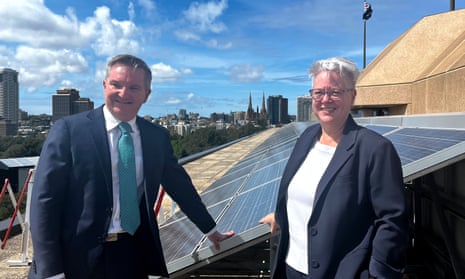Extract from The Guardian

Federal energy minister Chris Bowen, with NSW energy minister Penny Sharpe. Bowen said reaching renewable energy targets would provide Australia with a “strategic advantage”.
Officials say intervention is needed for Australia to reach its 2030 renewable energy target, as private investment slows.
Thu 23 Nov 2023 01.00 AEDT
Last modified on Thu 23 Nov 2023 01.02 AEDTThe climate change and energy minister, Chris Bowen, will confirm the expansion of the capacity investment scheme on Thursday after officials advised the government further intervention was needed to meet the electricity target and firm the grid as ageing coal plants retire.
Bowen said the government would underwrite 32 gigawatts of new electricity, consisting of 9GW of storage and 23GW of variable renewable generation. Fossil fuels, including gas-fired power, will not be eligible.
The government’s goal is to de-risk clean energy investments and shield consumers from price volatility during a transition to net zero emissions.
It follows evidence that investment in large-scale solar and windfarms has fallen significantly this year. The Clean Energy Council has warned the first half of 2023 was the slowest start to a year for financial commitments on major clean energy developments since 2017.
Analysts say while solar and wind are the cheapest forms of new energy generation, new farms will not be built at the pace required to meet the 82% target and live up to climate commitments without additional policy support. The government has also faced pressure to respond to the US Inflation Reduction Act, which included A$560bn support for clean energy and has escalated global competition for climate-focused investment.
It is unclear how much the capacity investment scheme, which will effectively replace the federal renewable energy target, will cost between now and 2030, or how much revenue is expected to be raised.
The scheme involves the government underwriting new investments in renewable generation and storage through “contract for differences” that share the risks between investors and taxpayers.
Contracts within the scheme are won through a competitive tender and include floors and ceilings for revenue earned by a development. If the revenue is higher than agreed, the proponent pays the commonwealth a percentage of the proceeds. If it is lower than agreed, the commonwealth pays the difference to the proponent.
The government says the costs of the contracts will not be disclosed publicly because telegraphing that information could undermine a competitive auction process.
The scheme has been piloted in New South Wales, South Australia and Victoria. Six successful projects in NSW – three large batteries and three virtual power plants, with a combined capacity of 1 GW – were announced on Wednesday. The proposed expansion will begin in April, with six-monthly auctions to follow until 2027.
As well as delivering its portion of the underwriting, the federal government will also negotiate agreements with the states and territories to underpin what it hopes will be an orderly transition to net zero emissions by 2050.
These agreements will cover a range of issues, including ensuring there are sufficient strategic reserves of generation in the market. Commonwealth underwriting will only support renewable projects, but the states can determine the form of the strategic reserve.
The significant expansion of the underwriting scheme comes ahead of Australia’s participation in UN climate talks in the United Arab Emirates later this month. Cop28 will include a global stocktake of progress on emissions reduction efforts. As countries prepare to gather, the UN has issued a stark public warning that the world is on track for a “hellish” 3C of global heating.
Before he departs for the Cop, Bowen will deliver an annual climate change statement to the parliament next week, and release an independent assessment of domestic progress by the Climate Change Authority. He will also meet state and territory energy ministers next Friday.
In a speech to the Lowy Institute this week, Bowen said reaching the renewable target in the electricity sector would provide Australia with a “strategic advantage when it comes to energy” because of an abundance of wind and solar resources, “enough to power our economy several times over”.
He noted there was “no geopolitical crisis that can stop the sun shining or the wind blowing”.
Bowen said the coal power fleet suffered thousands of hours of forced outages in 2022, leaving the grid short of forecast coal generation capacity for nearly a quarter of the year.
“This isn’t a political view, it’s a practical reality and reinforces the urgency of the transition to renewables,” the minister said.
But Labor is facing an intensifying partisan attack from the Coalition about the impact of large-scale renewable energy generation and transmission infrastructure on local communities.
The coordinated pushback includes opposition to a proposed windfarm area off the coast of the New South Wales Hunter region. The Coalition has proposed building small modular nuclear reactors – which are not yet commercially available – on the site of retired coal generators to complement renewable energy in the grid.
But the only company to have a small modular nuclear power plant approved in the US – cited by the Australian opposition as evidence of a “burgeoning” global nuclear industry – has cancelled its first project due to rising costs.
No comments:
Post a Comment